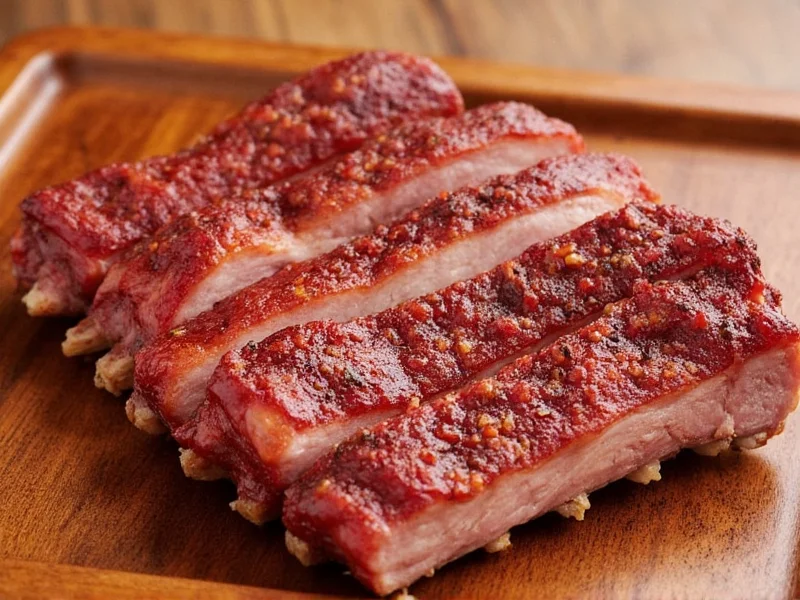Understanding the precise temperatures for cooking ribs separates satisfactory results from exceptional barbecue. While food safety standards provide minimum requirements, achieving that perfect balance of safety, tenderness, and flavor requires deeper knowledge of how different rib types respond to heat.
USDA Food Safety Guidelines for Rib Preparation
The United States Department of Agriculture establishes clear minimum internal temperatures for meat safety. For pork ribs, the absolute minimum safe temperature is 145°F (63°C) with a three-minute rest period. This temperature effectively eliminates harmful pathogens like Salmonella and Trichinella spiralis that could cause foodborne illness.
However, cooking ribs only to 145°F will yield meat that's technically safe but disappointingly tough. The collagen and connective tissues in ribs require significantly higher temperatures to properly break down into gelatin, which creates that desirable fall-off-the-bone texture.
Optimal Temperature Ranges for Different Rib Types
Professional pitmasters and competitive barbecue cooks follow different temperature targets based on rib type and desired outcome. Understanding these distinctions helps you achieve restaurant-quality results at home.
| Rib Type | Minimum Safe Temp | Recommended Cooking Temp | Texture Result |
|---|---|---|---|
| Pork Baby Back Ribs | 145°F (63°C) | 190-195°F (88-91°C) | Firm but tender, slight chew |
| Pork Spare Ribs | 145°F (63°C) | 195-203°F (91-95°C) | Perfectly tender, slight resistance |
| Beef Back Ribs | 145°F (63°C) | 200-205°F (93-96°C) | Rich, melt-in-your-mouth texture |
| Beef Short Ribs | 145°F (63°C) | 203-205°F (95-96°C) | Fall-off-the-bone tenderness |
Temperature Measurement Techniques for Perfect Ribs
Accurate temperature measurement proves critical when cooking ribs. Many home cooks make the mistake of checking temperature in the wrong location or using unreliable thermometers.
For precise readings, insert your meat thermometer probe into the thickest part of the meat, avoiding bone contact which can give false high readings. Digital instant-read thermometers provide the most accurate results, while leave-in probe thermometers allow continuous monitoring during the cooking process.
The "bend test" serves as a useful supplementary method: when properly cooked, ribs should bend easily when lifted with tongs, and small cracks may appear in the surface rendering the fat.
Temperature Strategies for Different Cooking Methods
Whether you're smoking, grilling, or oven-roasting ribs, temperature management differs significantly across cooking methods while maintaining the same internal temperature targets.
For smoking ribs, maintain a consistent smoker temperature between 225-250°F (107-121°C). This low-and-slow approach allows connective tissues to break down gradually without drying out the meat. The entire process typically takes 4-6 hours for pork ribs and 6-8 hours for beef ribs.
When oven-roasting, set your oven to 275°F (135°C) and expect cooking times of 2.5-3 hours for pork ribs and 3.5-4 hours for beef ribs. The controlled environment of an oven provides consistent results but lacks the smoky flavor of traditional barbecue methods.
Avoiding Common Rib Temperature Mistakes
Many home cooks encounter problems by misunderstanding the relationship between cooking temperature and internal temperature. One frequent error involves removing ribs from heat too early based on appearance rather than actual internal temperature.
Another common issue occurs when cooks wrap ribs in foil (the "Texas crutch") too early in the cooking process. While wrapping helps push through the stall phase, doing so before the meat reaches at least 160°F (71°C) can result in less bark development and diminished smoke flavor.
Remember that ribs continue cooking during the resting period. Always remove ribs from heat when they're 5-10 degrees below your target temperature to account for this carryover cooking.
Temperature Guidelines for Food Safety and Quality
While USDA guidelines provide the minimum safe temperature, barbecue enthusiasts understand that optimal eating quality requires going significantly beyond these minimums. The science behind this involves collagen conversion - the tough connective tissues in ribs don't begin transforming into gelatin until temperatures reach approximately 160°F (71°C), with the process accelerating between 190-205°F (88-96°C).
For those concerned about precise temperature control, investing in a reliable dual-probe thermometer allows simultaneous monitoring of both your cooking environment and the internal meat temperature. This equipment proves invaluable for achieving consistent results across different cooking sessions.











 浙公网安备
33010002000092号
浙公网安备
33010002000092号 浙B2-20120091-4
浙B2-20120091-4